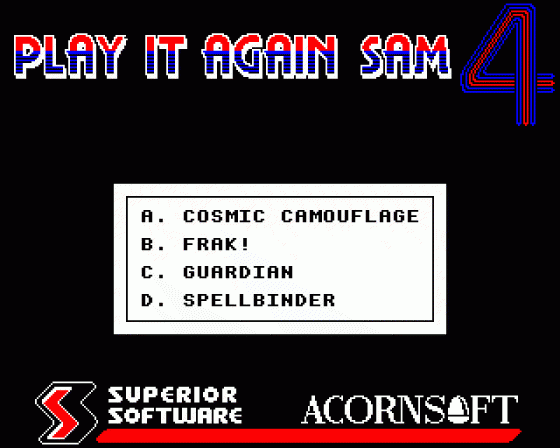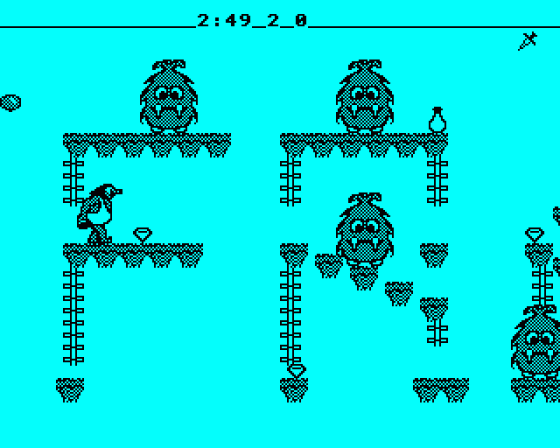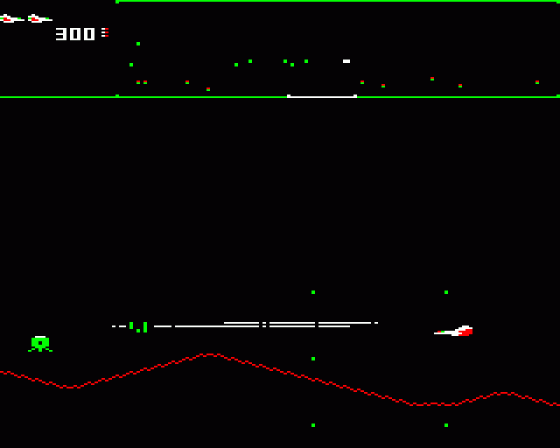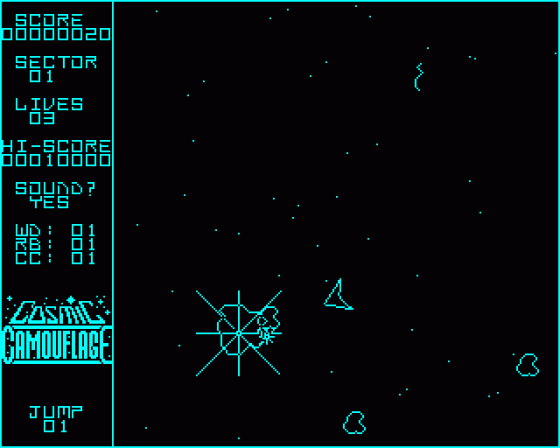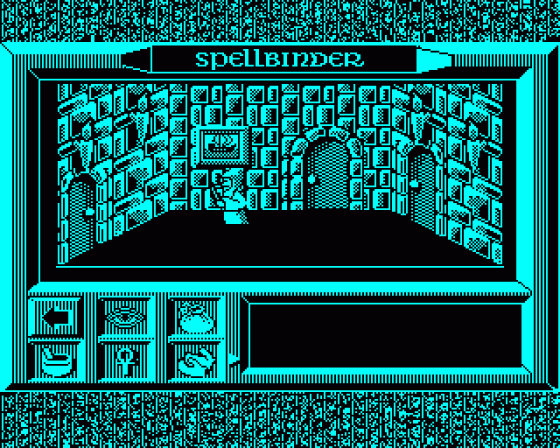
Electron User
 1st December 1988
1st December 1988
Categories: Review: Software
Author: Martin Reed
Publisher: Superior/Acornsoft
Machine: Acorn Electron
Published in Electron User 6.03
Like its immediate predecessor, Sam 4 departs from the standard set by Sams 1 and 2 - that of re-releasing games from Superior's back catalogue. Two of the titles on offer were originally released by another software house and the third is a brand new game, never before available in any form.
This idea of including a previously unreleased game extends the compilation's appeal to a number of software buyers who may not otherwise consider the package if they already had some of the featured titles separately.
The term cartoon quality graphics has been much abused when applied to computer games, but any Electron arcade addict who was around in the heady days of 1986 will still remember the first game to which that overused phrase could justly be applied. At that time platform games were just starting to become a bit stale, and something a little different was needed. The first game on the compilation - Frak - went the whole way and provided something very different indeed.
What made it so, apart from its amazing graphics, was the way that so many totally incompatible concepts, creatures and objects were combined with wild abandon to produce a game that bore no resemblance to the platform genre of the time, or indeed to anything else.
The star of Frak is a delightful little caveman by the name of Trogg, one of the unlikeliest celebrities ever to grace the Electron. The aim of the game is simple: You, as Trogg, must jump and climb around the screen collecting the many keys dotted around. Sounds easy, but there are many hazards to overcome.
The game features 72 levels, plus a built-in competition section, each about three screens wide. As you approach the edges of the screen the backdrop scrolls to the left or right so you can always see what is in front of you. This feature comes in very useful for spotting distant hazards. As you make your way up the first ladder and on to the rock platform above, you set eyes on your first Scrubbly. These are large and furry, have long teeth and a permanent happy stupid smile. But don't be fooled - they are quite deadly.
The Scubblys don't move, but sit awkwardly in your way - no problem for a heavily armed caveman. Unlike your Neanderthal predecessors, however, your secret weapon is not a wooden club or stone axe, but a yoyo. With a quick flick of the wrist you despatch the offending beastie and your path is now clear.
Clear, that is, of Scrubblys - you still have to contend with daggers that rain down from the sky and balloons that fly up from the bottom of the screen. Both have a nasty habit of appearing at inopportune moments, but fortunately your yoyo works just as well against them as it does against your ground adversaries.
Each level features a time limit, and unlike most games you don't lose a life if you run out of time - you suddenly find that night has fallen and your yoyo no longer works. At this point all the daggers and balloons seem to gang up on you, and if you fall foul of any of the monsters or flying objects, or simply miss your footing on a jump, you swiftly go to your maker with a cry of "Frak!"
When you have collected all the keys from the first level you are promoted to the second, where the rock platforms, ladders and Scrubblys are replaced by logs, handing ropes and small monkey-like creatures with the same fatal properties as the guardians of the first level. On the third level you make your way along a series of girders and up and down chains that hang from them. Your adversaries are now small squat creatures with bulbous noses.
After you have completed the first nine levels you are returned to level one to find that the screen has turned upside-down. Levels 10 to 18 are, in fact, levels on to nine upside-down. Levels 19 to 27 are further variations, levels 28-36 are levels 19-27 upside-down, and so on.
Level 73 is the first screen of Championship Frak, a very fast, difficult and thoroughly dagger and balloon-ridden version of the normal game. The competition associated with it has long since closed, but see how far you get anyway.
The game also includes a screen designer so you can dream up and save your own screens. It allows almost unlimited scope for producing difficult screens and nasty problems, and I think it is a pity no add-on screens were ever published.
The newcomer is an interesting variation on Asteroids and goes by the name of Cosmic Camouflage. It is a sequel to Acornsoft's classic game, Meteors. Certainly first impressions of the game - a small triangular ship surrounded by asteroids - might make you think that it was unchanged.
Cosmic Camouflage uses the same rotate, thrust and fire keys as Meteors, so any devotee of that game will feel immediately at home. However, the new version incorporates a number of 1988-style improvements over its predecessor.
Missing from Meteors, but features that have become standard in recent years, such as pause/restart, sound on/off and quit game, are present. Also, every hit has been spruced up with the addition of a four-pointed flash.
The game itself has also been radically improved. In Cosmic Camouflage, a direct hit on a large asteroid does not always produce two smaller asteroids, it can produce an asterite and a Hermit Craft or occasionally two Hermit Craft. These bounce around the screen at high speed causing fatal damage if hit.
They are worth destroying - self-preservation apart - so you can claim their valuable cargo. A vaporised Hermit Craft leaves behind a small canister which increases your supply of radiation bombs, warp drives or camouflage devices.
A radiation bomb is in effect a smart bomb, and acts like a panic button, splitting all the asteroids and destroying all asterites and alien ships. If the asteroids and aliens are closing in too quickly you can jump to another part of the screen. However, you reappear at a random position, sometimes with fatal consequences.
The Camouflage Cover feature which gives the game its name is very similar to the shield option in the original Atari Asteroids. When selected, your ship disappears and aliens no longer home in. However, you are not invulnerable to asterites. Later attack waves introduce Octanoids, Starcraft and Decanoids which home in on you, but are fairly easy to blast. Starcraft and Decanoids produce spores when blown up which also home in.
Cosmic Camouflage is a novel implementation of a classic, and if you enjoyed Meteors you'll love this upgrade.
The remaining games in the compilation are Guardian - originally released by Alligata, but now re-released on the Superior label - and Superior's own Spellbinder. The latter is another Superior offering that falls into the popular arcade-adventure category. It is, however, rather different from the other games of this type in that it puts less emphasis on the arcade aspect and more on adventure.
You play Eldon the Spellbinder, one of the Magelords, a brotherhood of wizards who rule the land of Lorraine. For many years peace and prosperity reigned over the land, but now that tranquillity is being threatened by one of your own number, the renegade Zorn.
Naturally, as protectors of the land, the Magelords must act to thwart Zorn's evil plans before it is too late. Guess which one drew the short straw? You start on the drawbridge of Zorn's castle, and once you have ventured over the threshold there is no turning back.
The game features no material weapons, but a good wizard does not need any - you must fight Zorn using your own magical powers. However, before you can cast spells, you have to make them by mixing certain substances.
You start off with three spells in your armoury, but a good wizard does not need any - you must fight Zorn using your own magical powers. However, before you can cast spells, you have to make them by mixing certain substances.
You start off with three spells in your armoury, but you will learn others along the way. Burned ashes, sulphur, toad's legs and the other substances all have magical properties that, correctly combined, will aid you in your quest.
The graphic features have been very well designed, with suits of armour, wooden tables and dusty bookcases all lending authenticity to your surroundings. My only complaint is that the animation of the monsters is rather jerky.
The layout of the castle seems to have designed to confuse, and a map will come in handy. No medieval castle would be complete without secret passages and hidden doors, and the Castle of Lorraine is no exception.
As might be expected, Zorn is by no means the castle's only inhabitant. You will encounter a variety of deadly creatures, all of which deplete your precious energy by varying amounts if you don't protect yourself or avoid them.
These adversaries include zombies, flying eyes and winged skulls. You can cast a spell to immobilise or ward off some of them, but the supply of raw materials is not limitless.
The game is completely icon-driven. Press the appropriate function key to search an object, mix ingredients, cast a spell, and so on. Your surroundings are displayed in 3D, not using isometric projection, but viewed from the front.
Spellbinder runs in Mode 4, so only two colours are displayed on the screen at any one time. However, I found that this led to only a small reduction in visual clarity and I found no difficulty in keeping track of my surroundings.
Spellbinder is not quite my cup of tea, but it is certainly very different, and if you like mapping and solving puzzles it is worth a close look.
Alligata is one of the longest established names in the software world, but one that has been dormant of late. This is set to change with the signing of a contract that allows Superior access to Alligata's back catalogue. The first title to come from this union is Guardian - an implementation of the coin-op classic DEFENDER.
For the benefit of anyone who is not familiar with Defender - or its Electron clones, Acornsoft's Planetoid and Micro Power's Gauntlet - you are charged with the task of defending your planet against swarms of alien invaders who are intent on kidnapping its inhabitants.
Same old scenario certainly, but it was original at the time. Defender was different from all the other games of the period because it featured sideways screen scrolling. Along the bottom of the screen is a jagged line representing the surface of your home planet. Dotted at intervals along it are a number of blips which represent the planet's inhabitants stranded helplessly on the surface.
Even as you start, wave upon wave of aliens are appearing in the skies above you, intent on capturing the humanoids in your care. The aliens will attempt to swoop down, capture a humanoid and take him off to the top of the screen. If one manages this successfully it becomes a mutant and chases your ship at high speed.
You must either shoot it or use one of your precious smart bombs. This will destroy every alien ship on the screen in one fell swoop and can be used as a panic button.
You start off with three lives, but are awarded an extra one after every 10,000 points. Ideally you should shoot the alien before it manages to make off with its prisoner. When you have destroyed a complete wave of aliens you are awarded a bonus according to the number of humanoids remaining, so you must learn to hit the aliens without damaging their captives.
If the alien is still near the surface of the planet, the humanoid will simply drop back to the ground unharmed. However, if the alien has managed to reach a considerable height above the planet, the humanoid will be killed on impact. Therefore, you must also learn the worthwhile skill of catching falling humanoids in mid-air and returning them to safety.
The displayed screen acts like a small window on the entire surface of the planet. Move left and right to cover the areas that are currently out of range. Fortunately, you have a long range scanner at the top of the screen to show where you are needed most. This shows the positions of all the humanoids and aliens.
On later levels when the screen can be overrun with many different types of alien, a smart bomb can clear the area - and amass a considerable number of points - in no time. Guardian is an excellent implementation of a classic no Electron owner should miss.
Overall this is another impressive compilation from Superior. The oldies are classics, and the newcomer is a variation on a classic so it's a compilation not to be missed.
* * * Second Opinion (By Janice Murray) * * *Superior has come up trumps again and produced another hit compilation to add to your collection. The only cloud on the horizon is the fact that as these games were so popular when originally released you may already have one or two of them as singles. However, I still think the package is worth every penny. Recommended.
Other Reviews Of Play It Again Sam 4 For The Acorn Electron
Play It Again Sam 4 (Superior/Acornsoft)
A review by Paul Thornton (Acorn User)
Other Acorn Electron Game Reviews By Martin Reed
Scores
Acorn Electron Version| Sound | 9 |
| Graphics | 9 |
| Playability | 9 |
| Value For Money | 9 |
| Overall | 9 |


